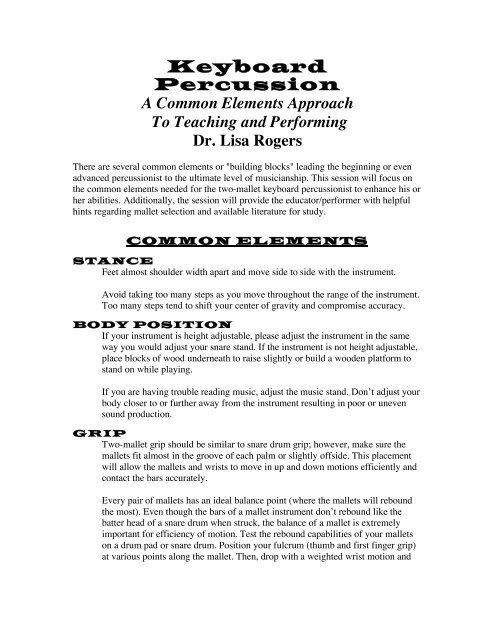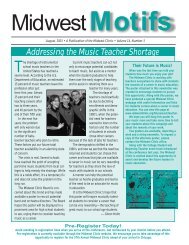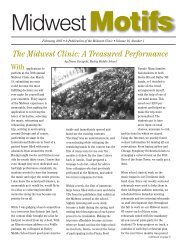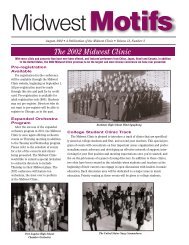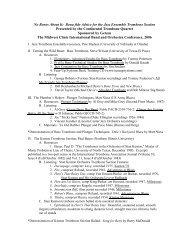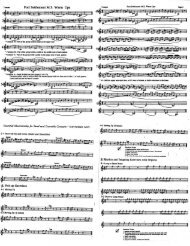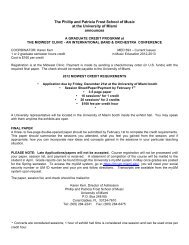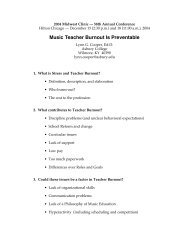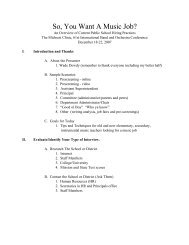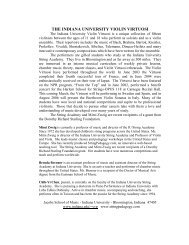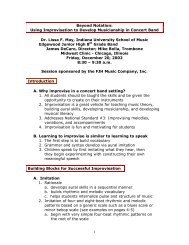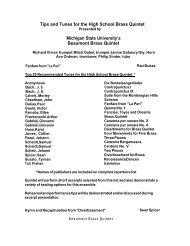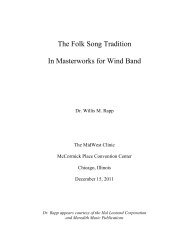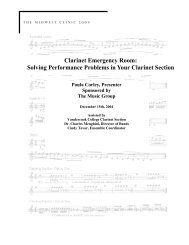Keyboard Percussion - The Midwest Clinic
Keyboard Percussion - The Midwest Clinic
Keyboard Percussion - The Midwest Clinic
You also want an ePaper? Increase the reach of your titles
YUMPU automatically turns print PDFs into web optimized ePapers that Google loves.
<strong>Keyboard</strong><br />
<strong>Percussion</strong><br />
A Common Elements Approach<br />
To Teaching and Performing<br />
Dr. Lisa Rogers<br />
<strong>The</strong>re are several common elements or "building blocks" leading the beginning or even<br />
advanced percussionist to the ultimate level of musicianship. This session will focus on<br />
the common elements needed for the two-mallet keyboard percussionist to enhance his or<br />
her abilities. Additionally, the session will provide the educator/performer with helpful<br />
hints regarding mallet selection and available literature for study.<br />
COMMON ELEMENTS<br />
STANCE<br />
Feet almost shoulder width apart and move side to side with the instrument.<br />
Avoid taking too many steps as you move throughout the range of the instrument.<br />
Too many steps tend to shift your center of gravity and compromise accuracy.<br />
BODY POSITION<br />
If your instrument is height adjustable, please adjust the instrument in the same<br />
way you would adjust your snare stand. If the instrument is not height adjustable,<br />
place blocks of wood underneath to raise slightly or build a wooden platform to<br />
stand on while playing.<br />
If you are having trouble reading music, adjust the music stand. Don’t adjust your<br />
body closer to or further away from the instrument resulting in poor or uneven<br />
sound production.<br />
GRIP<br />
Two-mallet grip should be similar to snare drum grip; however, make sure the<br />
mallets fit almost in the groove of each palm or slightly offside. This placement<br />
will allow the mallets and wrists to move in up and down motions efficiently and<br />
contact the bars accurately.<br />
Every pair of mallets has an ideal balance point (where the mallets will rebound<br />
the most). Even though the bars of a mallet instrument don’t rebound like the<br />
batter head of a snare drum when struck, the balance of a mallet is extremely<br />
important for efficiency of motion. Test the rebound capabilities of your mallets<br />
on a drum pad or snare drum. Position your fulcrum (thumb and first finger grip)<br />
at various points along the mallet. <strong>The</strong>n, drop with a weighted wrist motion and
check the number of rebounds. When you find the ideal balance point, you have<br />
also found where your fulcrum should be placed on the mallet.<br />
STROKE<br />
I try to think one stroke per wrist motion. As I strike a bar, I follow through and<br />
return to my starting point in preparation for striking the next bar. I don’t strike<br />
the bar, then stop, and lift again as preparation for the next stroke resulting in two<br />
motions.<br />
TOOLS OF THE TRADE<br />
MALLET SELECTION<br />
1. Glockenspiel/Bells: Brass, plastic, or hard rubber mallets<br />
2. Xylophone: Plastic or rubber mallets<br />
3. Marimba: Yarn or soft to medium rubber mallets<br />
4. Vibraphone: Yarn, cord, or soft to medium rubber mallets<br />
5. Chimes: Rawhide or acrylic hammers<br />
SAMPLE LITERATURE<br />
Methods<br />
1. Instruction Course for Xylophone-George H. Green M-D<br />
2. Modern School for Xylophone, Marimba, & Vibraphone-Morris Goldenberg E-D<br />
3. Fundamental Method for Mallets, Vols. I & II-Mitchell Peters (two and four<br />
mallets) E-D<br />
4. Primary Handbook for Mallets-Garwood Whaley (two and four mallets) E-MD<br />
Solo Literature (Two-Mallet,<br />
Accompanied and Unaccompanied)<br />
Marimba<br />
1. Prism-K. Abe D<br />
2. Etude 1955-E. Hatch M<br />
3. Furioso and Valse-E. Hatch E<br />
4. Extra Spices, Please-J. Gottry MD<br />
5. Etude in A-flat Major-C. Musser M<br />
6. Sonata-Allegro-M. Peters M<br />
7. Two Archaic Dances-A. Russell E<br />
8. Tempest-T. Ukena MD<br />
Vibraphone<br />
1. Joey’s Song-D. Mancini E<br />
2. Five Pieces-J. Metzger M<br />
3. European Gallery-B. Molenhof D<br />
4. Funny Vibraphone-N. Zivkovic E<br />
Xylophone<br />
1. Rags and Novelty Pieces by George Hamilton Green and Harry Breuer (i. e.<br />
Triplets, Bit O’ Rhythm, 1908 Rag, Jovial Jasper, <strong>The</strong> Whistler) E-MD<br />
2. Fantasy on Japanese Woodprints-A. Hovhaness MD<br />
Concertino for Xylophone-T. Mayuzumi M


